Introduction:
This is the continuation of a NES which has existed in various forms since summer 2006. Originally, it began as an experiment, an actual game of Civ3 which ran on my computer (Civ3 NES 1). Players gave basic orders, similar to a NES, which I would attempt to implement using a save-game editor. The idea didn't really work, but some great cultures were created by the players, and so things evolved into a normal NES (DNES 2). The game progressed in various interesting ways, though I did not let it go so smoothly. I always had trouble with the update format, finally resulting in a very lengthy hiatus. But through constant pain and hardship, many lessons were learnt. I'm determined to make this a substantial improvement over my previous efforts, and much more consistent.
The goal then, is for a relatively simple NES in an alternate world, continuing the story of many cultures and religions that have built up over time, while keeping things as realistic and fun as possible.
And yes, I have finally realised how selfish it is to try to monopolise to whole letter 'D', so I have added some letters to the name of the NES. Apologies for any confusion...
Players: No limits, anyone brave enough to join in will have my greatest respect, as will those willing to rejoin from the last version of the game. All I would like is for players to 'role play' a little. I don't meant elaborate diplomacy, but to plan orders from the viewpoint of this being a real world, rather than a simple game of world conquest. Which isn't to say that world conquest is impossible!
Players are
not expected to care too much about the sprawling history of this NES. I can let people know about the main issues, and if they are doing anything which seems out of character for their nation. The future is important! At the point at which the game starts, the old order is gone, and nations can be moulded to your will. Though, there may be fierce resistance to change.
Old players will of course have priority over their old nations, or the nations which descended from them. However, all unclaimed nations will still be open to players, and after a few turns, the 'rightful' claims will pass to anyone willing to play consistently. Brand new nations can possibly be made from rebels or tribal areas, but please PM me about that first. Generally, only unclaimed NPC nations are available to play.
NPCs: (Non-Player Controlled nations) The world will be full of them. I will control their actions and diplomacy, and they can be treated just like player nations. They may be boring and insular, or loyal allies, or erratic and back-stabbing rogues. They are not simply fodder for the growth of player empires - they will not roll over so easily as before, and are not to be underestimated.
Stories: Not necessary, but very welcome. Ideally, you'd only post a story - or something else - if you feel inspired, or have some background details that you wish to add to the NES. They may or may not lead to extra spending points, but more importantly they will give me a better idea of the way
you see things, and could have any number of subtle or not-so-subtle effects on the next update.
Spending Point system: There are no Eco points in this NES. You do not have Eco points, you cannot spend Eco points. So please do not mention Eco points, else I'll assume you have no interest in what the actual rules of this NES are! What you
do have, and what are actually the only numbers listed in the stats, are your 'Spending Points'. This system is carried over from the Civ3 NES, where players had limited input to the game. Though simple, it has generally met with approval by previous players.
To quote Warman17, these SP's represent the combined collaborative efforts of your nation. You will receive one spending point per turn, unless you are rewarded for stories or special achievements, in which case you may get more. You can spend as many as you like, and any unspent points will be 'banked' for use on any other turn, up to a maximum of 4 points stored.
The 'spending points'
cannot be traded or given to other nations.
It may help to think of these points as 'great people' from the Civ games. They represent great feats of organisation, effort, and willpower, rather than the economy or industry. Each one can create a mini 'golden age' but only in
one specific area, for example - Trade, Culture, Religion, Technology, Stability, Leadership, Military strength, Naval strength, Espionage, Exploration, Colonisation, Infrastructure/Construction, Wonders - or perhaps anything else you can justify. You can spend more than one point on the same area for double or triple or quadruple effects, or you can spend each point on a different area. In any case, they
cannot be split into fractions, so there may be some hard choices to make about how they are used.
The amount you get has nothing to do with the strength of your nation. As such, its a way of giving all players an equal amount of 'divine intervention' in the NES. However, those points used by more powerful nations will generally have more impact than those used by weaker nations. This should all become clear as the game progresses...
Rival Factions: I'm aiming for this to be a big part of the NES, and a counter to some negative aspects of player behaviour. Rival factions in your own nation may be as difficult to deal with as enemy nations, especially as your nation gets larger and more powerful. They may resist any changes you attempt to make, or may gain unwanted influence because of your actions. If rival factions take over, they can change the government and do various things against your will. On the other hand, you may want to deliberately engineer an overthrow of a weak or corrupt leadership. You can also try to set up rival factions in other countries, for various fun effects.
Researching Technology: In contrast to the earlier version of this NES, players can no longer request specific new technologies to research. Most of the time, the best you can do is throw money - or 'spending points' - at scholars and engineers, and hope for the best. What they actually come up with depends on the country's situation and what the most pressing needs are. Sometimes, though, various new ideas will be brought to the world's attention, and you will be able to choose which ones to invest in. These restrictions are an attempt at realism, and to prevent a headlong rush towards industrial-era weapons and machines.
Orders: Orders should probably be by PM, and should include three essentials: spending point usage (if any), confirmation of any deals with other players, and overall goals for the turn. I'd much prefer something as opposed to nothing - even one line would do, if you don't have time. Generally, a few paragraphs should be enough detail for this NES, maybe more in times of war. There will be little benefit to writing more than that - honestly, I am horrified by some of the huge orders I've seen in the 'show me your battle plans' thread! The military stats are deliberately vague so that, hopefully, people will take a wider view instead. That is, general tactics and methods, overall goals, acceptable risks and losses, conditions for peace, etc. Usual stuff like conscripting, hiring mercenaries etc is all possible too. Generally, I don't want to keep track of lots of little tricks and traps and intrigues, unless it is absolutely essential. Note that, given the time frame, wars are likely to begin and end in the same turn, unless they are really epic wars. The century-long conflicts of the past will not be repeated in this version of the NES!
As mentioned, there isn’t anything else to spend apart from the 'spending points', which by the way are
not Eco points! Even if nothing is spent, your nation will still gradually develop, explore and expand by itself. So feel free to say what general direction you’d like the nation to take, and set general orders for building, army recruiting, researching and settling etc. You don't have a treasury listed in the stats, but you can still set general priorities for government spending, which will be taken into account during updates.
Map: Should be self-explanatory. Grey areas are tribal lands, though the polar reaches will be basically uninhabited. Black borders are established, guarded frontiers - they may be missing if the border has recently changed, or if it is the front of an expanding colony. The black shroud hides areas not commonly known about - some nations may get private maps of their own if they go exploring. Cities are shown with larger blobs for higher populations. A gold star indicates a capitol city of an independent nation, a silver star the capitol of a vassal-state.
Various other icons have been kept from the NES's origins as a Civ3 game. You may want to look out for resource icons - the grey lumps represent various useful metals, while coal will become increasingly useful as a fuel for industry. Timber also serves as a fuel, as well as making it easier to build ships. Fruit and crops will obviously provide more food, to support larger populations and bigger cities. Other icons are various luxuries which will be beneficial to trade. The icons have a wide radius, and so might be shared by various different nations. Yellow trade arrows show the location of major trade centres, which may attract all kinds of travellers. Finally, the blue cogwheel represents an area with fledgling industries of various kinds, which again will help the economy, and war production also.
Updates: These will generally cover around 8 years or so, and probably less if there are many wars and important events taking place. I won't dare to set a strict schedule for deadlines and updates, so things will be flexible. However I do aim to update more in less time than previous versions of this NES. This time around, my aim is for the updates to provide only the facts, with extra 'spotlights' added sometime afterwards, on request of players, so as to avoid delaying things. Random issues may also appear for certain players, presenting some tough choices about how to proceed. There may also be some random statistics and rankings to show how nations compare. Things should become clear after the first update.
Stats Description:
Size Ratings: tiny, small, average, large, huge, gigantic
General Ratings: terrible, poor, average, good, excellent, outstanding
Influence Ratings: weak, notable, strong, mighty, transcendent
As you see, there aren't many different notches on these scales. Each rating is quite broad ranging. When a stat changes, it means there has been a really significant increase, or decrease.
Note: Any (+) symbol next to a stat will mean that it is improving rapidly, even if it hasn't jumped up a rating from one turn to the next.
Leadership: Only detailed for 'important' nations. There may be a certain ruler, whose age will increase with time, and will eventually die. If it isn't an 'elected' position, then the number of heirs will be listed. Small numbers of heirs make the ruling family more vulnerable to assassination, while lots of heirs could cause in-fighting, treachery, and general squabbling for position. 'Weak' leaders are easier to replace and less influential than 'Strong' ones. There may also be abstract bodies of people, 'noble assemblies' etc, which also have a certain influence rating. If power is shared, then each entity is listed in order of authority and influence, which is likely to change over time.
Ruling Faction: This is referring to the current rulers, or at least to the most influential advisors behind the throne. They may or may not be affiliated with a certain type of government, or culture, or nation, or ideology.
Rival Factions: There probably will be some, and if they grow stronger than the ruling faction, then a revolution of some kind may occur - which isn't always a bad thing. There could be a swift overthrow, or a bloody and prolonged civil war. If there are several equally-balanced rival factions fighting for power, then things may not be resolved so easily. If and when a new faction takes power, then the actual leadership may or may not change, depending on the situation. For example, the same monarch may continue to reign, but with a different set of advisors behind the throne. Note that rival factions may appear due to the actions of other countries, and may receive assistance from abroad.
Main Religions: The faiths and philosophies that have a substantial following - not including the various minorities that will probably exist. The dominant religion(s) may affect relations with other countries. They also have different effects on the society (see Current Info below, for a list of religions). Some religions can co-exist peacefully, while others are likely to cause violence. It may or may not be in your interest to make one of them the officially-backed 'State Religion'. You can attempt to 'suppress' a religion, or at least 'discourage' it, though obviously this may upset large parts of the population. It is also possible to create your own religion, if you can provide some suitable background and description for it.
Main Cultures: The cultures of the leadership and bureaucracy. Peoples of the same cultures can be more easily governed. If you conquer lands with different cultures, they will be harder to govern, and may be more prone to rebellion etc. Though, over time, conquered people may be assimilated into your culture. There is a world culture map (see Current Info below) which shows the main areas of influence. Due to historical reasons, a nation may have a culture listed here that isn't actually present in any of its territory anymore, but remains part of the aristocracy. Relations between nations are helped if they share the same culture.
Society: A brief description, together with any major problems. Everything listed here can be changed, given enough time and effort. Note that extremely generic terms are used - 'feudalism' refers to any system where nobles and aristocracy place limits on how and where people live. 'free peasantry' is more liberal, but does not mean that people actually have any rights as such. The idea of true 'citizenship' may come into play later on. 'Tribal' societies are generally harder to meddle with, though they are more resistant to invasion or disasters. An 'unstable' society isn't going to be at its best - this refers to a situation where the central government is losing grip, and it is much more likely that rival factions will make a bid for power.
Economy Rating: The average wealth of the nation, compared to the global average. Note that a larger nation will have more real wealth than a smaller nation with the same rating listed here. Though, it is easier for a small nation to increase its rating. A good economy makes it easier to do just about anything, whereas a poor economy will be making things harder. Although the economy is handled in an abstract way, you can still set the main spending priorities in your orders. It is possible to raise taxes and squeeze the economy harder, at the risk of lowering the economy rating in the long term. Economy also affects the confidence of your people, though it is hardly the only factor. There may even be reasons why you'd want to deliberately harm the economy - poverty can often spawn radical ideology, for one thing. Note that the economy can fluctuate due to all kinds of events, whereas infrastructure is only vulnerable to major disasters, wars, or complete social collapse. Finally, may I remind you that there are no Eco points in this NES!
Technology Rating: Like other ratings, this is relative to the global average. So if it stays the same for many turns, it doesn't mean that no progress is being made! Technology will give various advantages in all areas - warfare and trade in particular.
Infrastructure: A mixture of both urban infrastructure and things like roads, farms and forts. These are 'solid' investments. A higher infrastructure rating will help with all other areas, but especially with population growth, economy and technology. It will also help to prevent random things like disease and famine. Infrastructure in the form of roads, barracks and stables will also aid military movements. Forts are also taken into consideration here, as they will often be minor centres of manufacturing and weapon making, as well as barriers to invasion.
Wonders: Generally speaking, unlike previous versions of the NES, and indeed other NESs, wonders will no longer give specific bonuses to your stats. Most of the older wonders are no longer listed, though they may get mentioned in updates from time to time. I don't wish players to start 'projects' to boost specific stats, as spending points can be used for that directly. This time, wonders are more about prestige, confidence, and leaving a mark on history. They will also relate to specific cities and areas, more so than having nation-wide effects. Their benefits are more subtle, but just as powerful. Any new wonder should be something truly wonder-ous, and should also be some kind of physical monument that can be constructed, as opposed to an abstract concept. Huge engineering works may also count as wonders, at my discretion - the 'Great Canals of Antalya' are one example already in existence.
Current Army: This refers to the soldiers who can fight at a moments notice - or at least, a few days notice. Size, quality, leadership, and supply status are listed. Note that 'quality' is a mixture of weaponry, experience, training and loyalty - which, for simplicity, are all lumped together, at least for purposes of these stats. Improving quality will take time, effort, and will require more from the economy. Improving supply and maintaining large armies will also drain the economy as you might expect. To increase the size of the army, you can accept volunteers on a gradual basis, or more likely, you can issue conscription orders. It is perfectly reasonable to suddenly raise and disband soldiers as needed. Note that disbanded soldiers aren't 'lost', since they will leave their weapons in the armoury, rejoin the conscript pool, and probably add experience to it, increasing its quality.
Conscript pool: This refers to the conscripts that can be raised with a few months notice. Rather than slowly increasing the size of the army over many turns, it is possible to conscript large numbers of soldiers to fight specific war, and perhaps to go back to civilian work within the same turn. Conscription will drain the economy, both from the cost of equipping soldiers, and the loss of manpower working in the fields etc. It may also cause unhappiness, depending on the situation. There could also be mandatory peacetime training etc to improve the quality of the conscription pool, but this will be another drain on the economy, and will generally be unpopular with people trying to get on with their ordinary lives.
Army Doctrine: These 'doctrines' will affect how your army acts in battle, beyond what you can reasonably put in your orders. They will also determine what kind of troops you have in your army, rather than relying on a long list of UU's. You will have a choice of one doctrine to focus on exclusively, or two to mix together. More may become available later, as armies become more experienced and sophisticated. There are certain default doctrines (see Current Info below), and you can develop your own custom doctrines with a little time and effort - provided you can give a reasonable explanation in your orders/stories. Changing doctrines can also have adverse affects on quality and leadership for a while, until the new tactics are fully adopted. Doctrines can also affect how fortifications are built and used, and maybe even have effects on the society as a whole.
Navy: The floaty version of the army. Note that, currently, you cannot conscript boats - increasing the size of the navy is more of an undertaking than conscripting troops, and will depend more on the status of your economy and infrastructure, as well as the number of coastal cities under your control, and sources of timber.
Navy Doctrine: As with Army Doctrines, these will determine how your navy acts in battle, as well as what kind of ships are most common in your fleets. Some 'doctrines' may be the same as those for the army, but others may be different (see Current Info below). And, as with the Army Doctrines, you can develop your own types, provided you can give a reasonable explanation in your orders/stories.

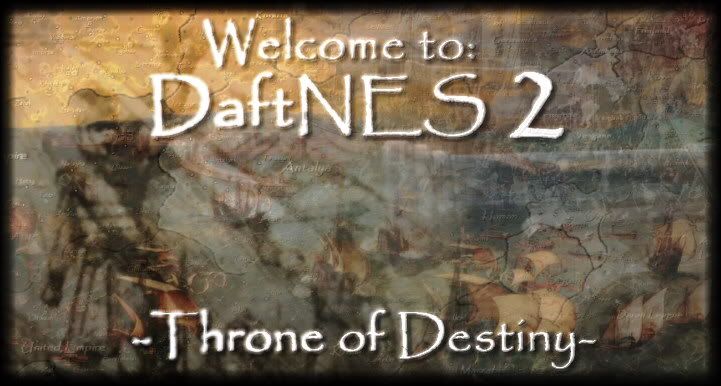




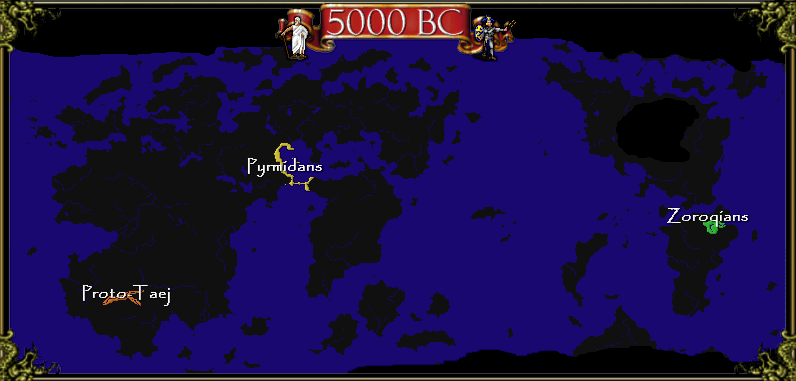
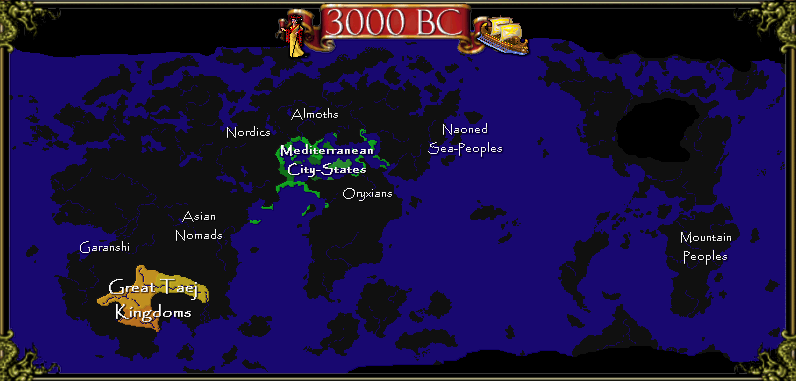
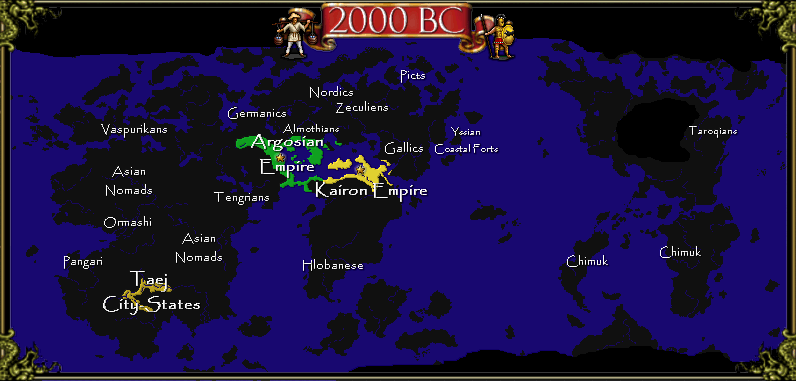

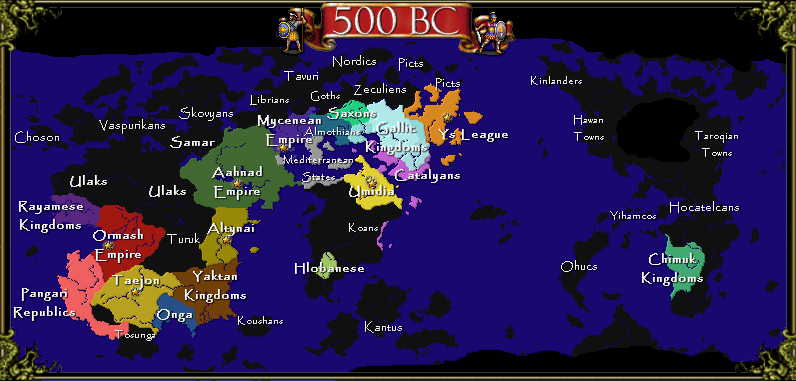
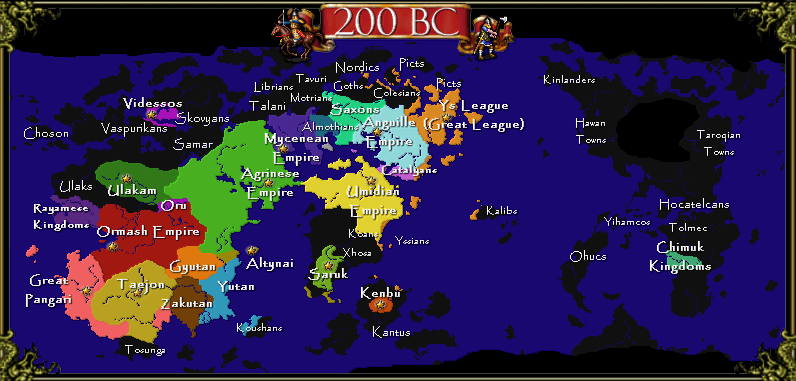
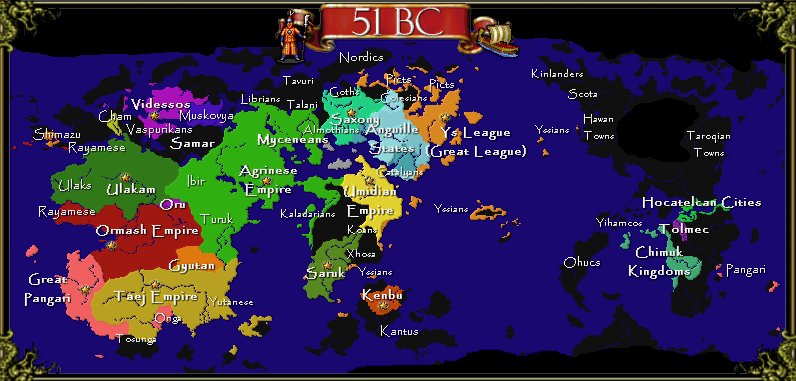

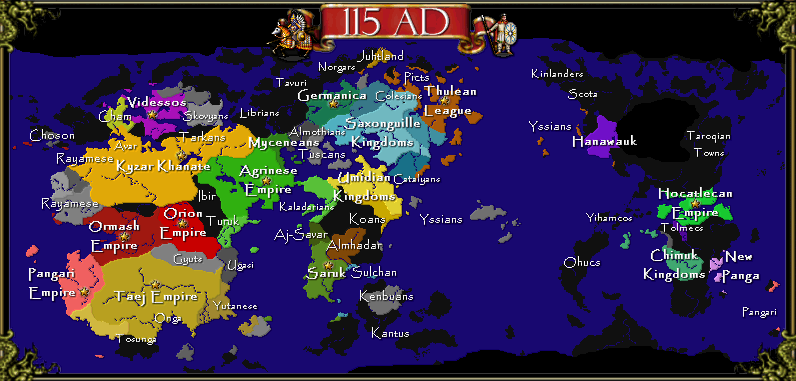


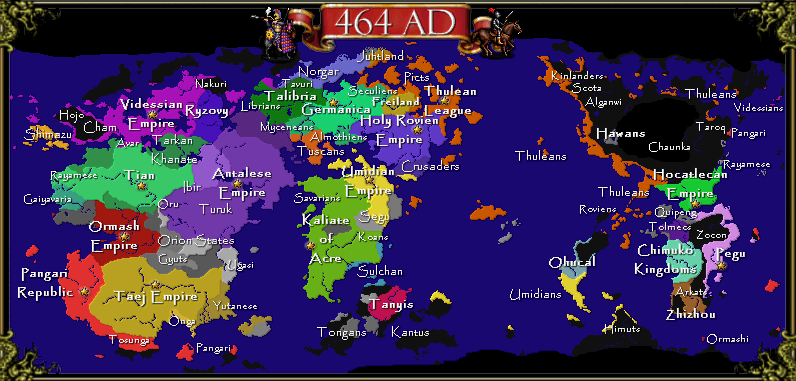
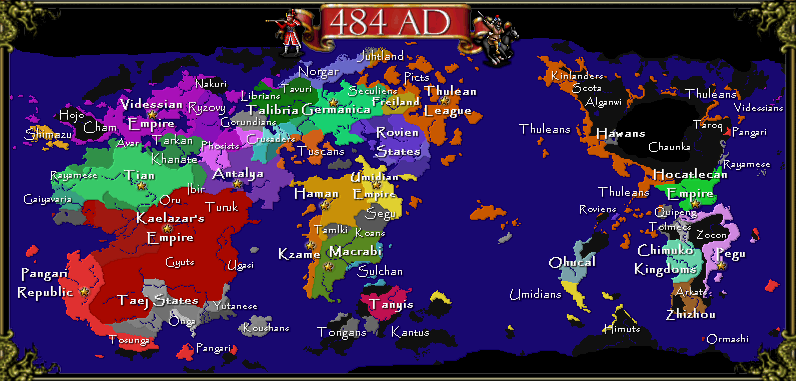






 . Macrabi of course.
. Macrabi of course.